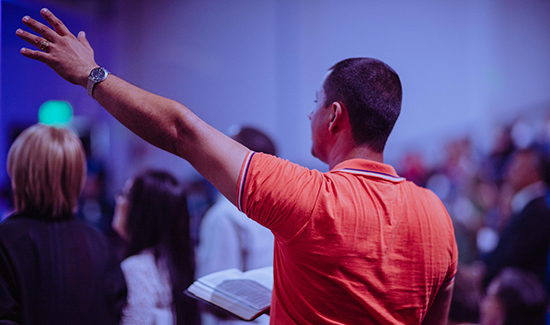Growing Churches by Helping Church Leaders Keep First Things First | By Glenn and Holly Packiam
Steps to help busy church leaders prioritize relationships, this article is excerpted from Glenn and Holly Packiam’s book, The Intentional Year.
How do we know which relationships to prioritize? What would that even look like?
Glenn:
When Holly and I started doing our retreat each year, we began to incorporate a time of praying and talking about which relationships the Lord was leading us to invest in more. We look at it in terms of circles.
⦁ The smallest circle is for our family.
⦁ Then, in concentric circles of increasing size, we talk about the next layer out (usually extended family and close friends).
⦁ Then, we move out another circle to friends and colleagues (though there is some overlap with the close-friends circle).
⦁ Next are the staff or key volunteers in the church.
Now, to be clear, when we’re talking about investment, we’re not talking about the people we have daytime, workday appointments with. We meet with anyone from the church who needs help, and we often have ongoing meetings with a few whom we are discipling. This is about relational investment outside the nine-to-five workday.
Once we’ve sketched out these circles, we then discuss practices or rhythms of connection with the people in our life. It includes things from dates with each other, one-on-one time with the kids, monthly meal groups, quarterly retreat days with friends, overnights with each other, vacations with the family, and more.
It’s easy to feel guilty about identifying relationships in this way. But keep in mind that even Jesus had three who were closest to him, twelve who went everywhere with him, and larger groups who followed him around — not to mention crowds whom he taught, fed, and healed.
Paul had relationships that were life-giving to him. The lists of names often found near the end of his letters — you know, the part we often skip! These lists give us a window into his life.
There are no lone rangers for God.
There is no even-handed way to “be there for everyone.” In fact, trying to do so leaves you absent from everyone.
It’s also helpful to remember that the whole point of praying through this once or twice a year is that there are different seasons for different levels of cultivation or investment in different relationships.
We’ve been blessed to live and work with friends that we have known for over twenty years. We’ve realized that this is a gift not to be squandered. But it is hard to schedule in time with everyone — especially with four kids who are all pretty active in dance, musical theater, and sports. Most evenings, we’re just shuttling kids around for hours. Seriously. Not an exaggeration. So, there are very few evenings in a week that we can host or attend a dinner.
We have found that it’s helpful when praying and discerning to ask ourselves which relationships we should lean in to, which ones we should let lie, and which ones we should let go of.
Lean In, Let Lie, Let Go
Holly:
The relationships we choose to lean into are the ones that not only matter most — family and close friends — but also have a time-bound sense of priority. For example, we’re so mindful that our teenagers only have a few more years left in our home. They’re at the top of our list.
The relationships to “let lie” are not ones to ignore. These are simply ones that, if you get together a handful of times a year, it would be just fine. They’re important, but not the ones to build frequency into.
The ones to let go of are much harder to talk about. Often these are relationships that feel one-sided, where you’re doing all the work and they don’t seem to care.
It’s important, though, to ask them about it before silently writing them off! You could say something like, “Hey…I sometimes feel that if I didn’t initiate anything with you, you wouldn’t really care. Is that an accurate picture of things?”
I have learned that people often are surprised to hear that. Not everyone is an initiator. If they respond in a positive way to the question, that’s a sign of valuing the relationship. Sometimes all that is needed is a clarifying conversation.
The other “let go” relationships are those that are just unhealthy. They drain you not because they need something but because they don’t know how to give and receive love. Lots of people — including us! — are awkward about relationships.
But some people are toxic. They’re constantly griping about other people, leaking out their pain and hurt, trying to build alliances and taking sides, or driving a wedge between a group of friends or even in the church. These are the ones to let go of.
Here are some questions for your reflection:
⦁ Who are the people who help you pay attention to God’s work in your life?
⦁ Who are the friends who walk with you and challenge you and encourage you? How can you make more room for them?
⦁ How can you close the gap, bridge the space between, and become a better friend?
⦁ Which relationships do you need to let go or pull away from?
⦁ Which relationships do you need to let lie for a season?
⦁ Which ones should you lean into?
⦁ What sort of rhythm would that take?
Reflect on these questions to get a sense of the landscape of your relationships. The intentionality will equip you to step into a more flourishing season of relationships ahead.
Greenhouse of Growth
Intentional practices help us abide in Christ — not only for the sake of our joyful union and intimacy with him, but also so that he can produce fruit in us for God’s glory and for the sake of the world. Circles of relationship are certainly a key part of cultivating our relationship with the Lord. But they function in another way, too.
Relationships are the greenhouse for growth. In the context of intentional community, we have opportunities to cultivate and even evaluate the fruit of the Spirit in our lives. Let me explain.
Think of the fruit of patience. How do you know if the Holy Spirit is producing patience in you if you are never in situations that require it?
When you live with intentionality about your relationships, you will be in a mix of symmetrical and asymmetrical relationships — relationships that are mutual, and relationships that are more one-sided.
If you’re a parent, your relationship with your child may be intentional, but it will never be mutual. A parent will always love and give and serve their child more than their child could ever love or give or serve their parent. And so, it should be. But relationships that flow more in one direction tend to be costlier. And they require more patience.
Even among friends — which are considered “mutual relationships” — we need patience. And forgiveness. And gentleness. And faithfulness. This fruit only develops in the context of community. Relationships reveal our need for the fruit of the Spirit. And relationships become an essential part of the ecosystem in which the fruit grows.
That’s why being intentional with relationships matters so much. If you are laissez faire with relationships, thinking that “whatever will be, will be,” you will walk away when a relationship gets strained or difficult. But that’s often precisely the moment when the Holy Spirit wants to drive your roots down deeper and push fruit outward in your life. Don’t quit. You won’t want to miss the moment.
Adapted from The Intentional Year by Glenn Packiam and Holly Packiam. Copyright © 2022. Used by permission of NavPress. All rights reserved. Represented by Tyndale House Publishers, a Division of Tyndale House Ministries.






